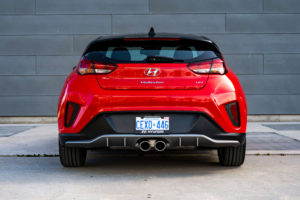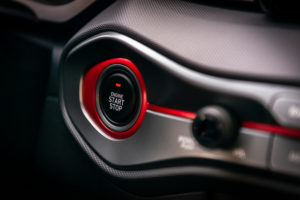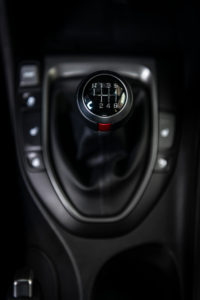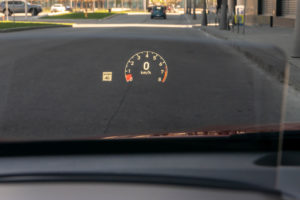It’s hard to believe Hyundai released its 3-door hot hatch, the Veloster, back in 2011. For 2019, this hot hatch gets styling and performance tweaks while keeping its distinct shape, making the 2019 Hyundai Veloster 1.6L Turbo a must-drive for autocross drivers and performance enthusiasts.

First impressions
The Racing Red model I drove had Hyundai’s darkened roof treatment. Even without that option, the Veloster sports a slightly more aggressive profile than that of its already low-slung predecessor. Only the most daring tuner would mess with the suspension. As it stands, the standard 18” wheels fill the arches.
Designers in Korea and California flanked the new vertical front grill with headlights and daytime running lights, both available in LED form. The car shares its grill with other Hyundais, a signature part of the automaker’s current design direction. The twin-tailpipe diffuser-infused rear end, on the other hand, is signature Veloster. (Hyundai’s code: two exhaust tips for the turbo model, one for the non-turbo. Or you can simply look at the rear hatch – it will say 1.6T.)

image courtesy Hyundai
Interior
Red stripes run down the leather seats. They match red accents on the steering wheel and around the engine start/stop button.

image courtesy Hyundai
The side bolsters don’t make the seats overly narrow, but the cabin feels tight nonetheless. Maybe that’s also because the moonroof takes away headroom that my 6’5” frame could have used.
On the bright side, the manually adjustable heated seats and heated steering wheel reminded me of Hyundai’s ongoing mission to cram value into the car by forgoing less-used features like power adjustments for both.
What you can see and touch feels well-designed and properly put together, from the red accents on the dash that mesh with those on the seats, to the straightforward controls on the centre stalk, to the (standard) leather-wrapped steering wheel and shift knob.

image courtesy Hyundai
Rear seats are little more than suggestions, standard fare in the hot hatch segment. The passenger-side rear door means you won’t need to lower the front seats to let people in and out of the rear. Yes, Hyundai stuck with this signature Veloster touch. It’s a mild inconvenience if the driver wants to hang a jacket behind the front seat, but the tradeoff is a larger driver door that enables easier driver ingress and egress.
Hockey bag test
A surprisingly deep hatch fits the bag, and it won’t prop the privacy cover up. I say “surprisingly deep” because there’s a spare tire under the hatch floor.

In-cabin technology
Start up the Veloster and a heads-up display pops out of the dashboard. Aside from standard fare like speed, posted speed limits and navigation instructions, the HUD tells you when a vehicle is in your blind spot. This is one of the few bits of information that transform HUDs from gadgets into safety equipment.
I drove a Rally Edition Veloster several years ago. Since then, Hyundai has thankfully eliminated the key (though not on the base Veloster). You just press the Start/Stop Engine button while keeping the fob in your pocket now.
The fully-loaded infotainment system runs from either a 7” or 8” touchscreen. Hyundai packed so many features behind the screen that it now offers a separate manual for the system (an increasingly common phenomenon among automakers). My tester, with the 8” model, pumped tunes and audiobooks through an Infinity premium audio system featuring eight speakers. For the first time in memory, I bypassed Bluetooth pairing and simply used Apple CarPlay. Hyundai also includes Android Auto.
I had two USB ports for phones. Just under those sat the optional wireless charging pad.
Driving
The 1.6L turbocharged engine proved satisfying. 201 horsepower and 195 lb-ft of torque quickly propels this hatchback off the line, enough to press occupants gently back into their seats. Passing power was a quick downshift away.
Hyundai also offers a 2.0L engine in the base Veloster. It can produce 147 horsepower and 132 lb-ft of torque.
If you’re going to drive the Veloster the way its looks suggest it should be driven, go for the slick-shifting 6-speed manual transmission. Other options are 6-speed automatic 7-speed dual clutch models.

image courtesy Hyundai
If your eyes wander just to the left of the shifter, you’ll see a button labeled “Sport.” You might as well call it “Mr. Hyde mode.” You’ll know you’re ready to be Hyde if the heads-up display circles the speed number with a tachometer.

image courtesy Hyundai
The car also has Dr. Jekyll (a.k.a. “Normal”) mode for more restrained driving, although a tap of the accelerator gives you all the juice you’re likely to need.
This button may make sense in an automatic transmission car – the Veloster delays upshifts when you accelerate to get more horsepower out of the engine. I question the value of this button when paired with the 6-speed manual, otherwise known as the “original sport mode.”
Ride quality is firm but civilized, again what you can expect from a sporty hatchback.
Power is great, but control is essential. I flung the Veloster quickly around several corners and it held the road as though it were on rails. Hyundai credits changes like the standard multi-link rear suspension and torque vectoring control for sporty handling that left me increasingly confident during my week with the car.
All this presumes you’re going forward. Massive blind spots to the rear made parking next to concrete pillars and other vehicles a bit nerve-wracking. Drivers better keep the rear-view camera lens clean.
Besides the camera, standard active safety technologies include rear cross-traffic alert warning, vehicle stability management, electronic stability control, electronic brake force distribution and, of course, the blind spot collision warning.
Fuel economy
For the manual transmission model I drove, Hyundai published city/highway/combined numbers of 9.4/7.0/8.3. The automatic transmission does a little better. Mileage on 2.0L models is similar.
Pricing
Hyundai offers the Veloster in eight trim levels split among three classifications: Veloster (1), Veloster Turbo (3) and Veloster Turbo Tech (3). The Veloster 1.6L Turbo Tech I drove starts at $28,899 MSRP. The base Veloster 2.0L retail for $20,999 MSRP.